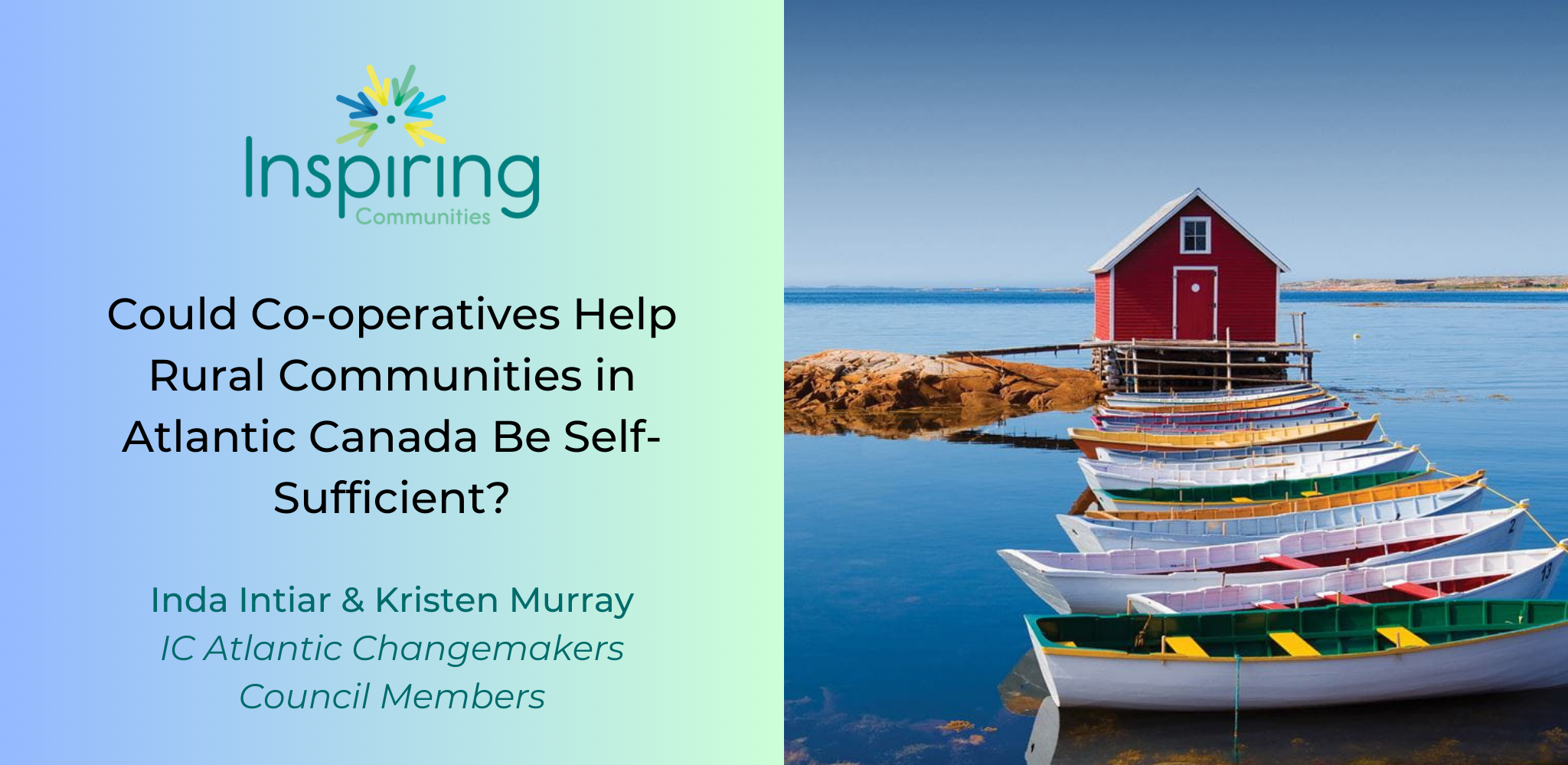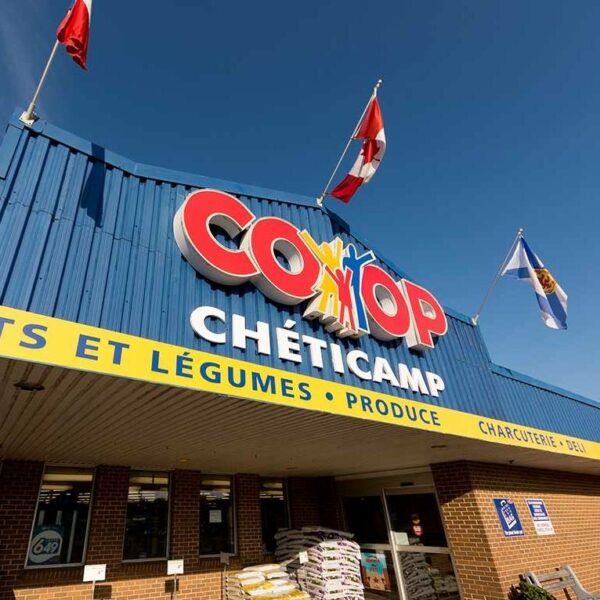Could Co-operatives Help Rural Communities in Atlantic Canada Be Self-Sufficient?

Co-written by Inda Intiar and Kristen Murray, members of Inspiring Communities Atlantic Changemakers Council.
In 2016, the community of Dorchester, on the bank of the Petitcodiac River in New Brunswick, was in what seemed like a hopeless decline. Dorchester’s population had shrunk so much over the years due to various factors that the provincial government was ready to close the only school left in the community. There were 54 students then.
To save the school, dozens of community members met to create a population growth strategy. They managed to get the provincial government to postpone the school closure for four years. Then, they formed the Greater Dorchester Moving Forward Co-operative based on a social enterprise business model so they wouldn’t have to only rely on external funding. Relying on volunteers and community spirit as currency, the co-operative put the strategy into action.

Seven years later, the school has not only remained open, it also received UNESCO designation, and the number of students has nearly doubled to 104 as young families began moving into town.
The co-operative also built, and now operates, an aquaponic lab at the local school that grows fish and dozens of plants per month to feed students and food-insecure families in the community.
The co-operative owns properties used as rental offices for local businesses, as well as long-term and short-term accommodations. They run a robust food security initiative with a community garden, a community fridge and a teaching kitchen, with plans in the works to develop a full Community Food Hub with a commercial kitchen, healthy cafe, farmers market and space for food-related programming
Wendy Keats, a community economic development consultant who has been helping with this plan since the beginning, says the co-operative model gives residents a sense of ownership that encourages them to do the work that needs to be done, alongside the board and staff, and community partners. Members are the ones steering the strategic priorities of the board.
“Members have this sense that they are a part of something and they are an owner. That also means there are obligations,” she said.
The 60 volunteer members of the co-operative have to commit 10 hours each per year. While it doesn’t sound like much, a baseline of expectation helps keep them accountable.
The Greater Dorchester Moving Forward Co-operative is just one example of co-operatives filling gaps for community services in rural Atlantic Canada.
The Fogo Island Co-operative Society is one of the most well-known examples of successful co-operatives in rural Newfoundland & Labrador. The people of Fogo Island decided their fate in 1967 when they refused to resettle and, instead, developed a co-operative that would provide the island with not only sustainability, but also prosperity. They are still the largest employer of the island. This article, written on their 50th anniversary, does a wonderful job of describing this story and offers more perspectives on the challenges they had and still do face.
The North Shore Central Ambulance Service is unique as both a co-operative and a charity that serves 10 communities on the North Shore of Newfoundland & Labrador. A group of concerned residents came together to raise the funds needed for the ambulances, medical equipment, and paramedics. What they have accomplished is above and beyond their essential role, as they have also inspired a model for community-based essential services that are governed and operated by people from the communities that they serve. The co-op also addresses other community needs including offering a Community Warming Centre, a Community Kitchen and a Community Garden.

The Cheticamp Co-operative, based in the Acadian town of Cheticamp on Cape Breton Island, N.S., transformed its local area and made a huge impact on the community and economy. Together with the local credit union, they worked to provide an economic engine for businesses outside of traditional industries like fishing and tourism, creating new jobs and securing the future of this small region.
“Without the co-op, the town would not be as vibrant as it is today,” said Tyler Paturnel of the Cheticamp Co-op.
They operate a grocery store, Home Hardware store, funeral home, and are now involved in commercial real estate and affordable housing spaces as well. This article dives deeper into the story of Cheticamp.
Rock Barra Artist Retreat Co-operative is a “hidden gem on PEI’s North Shore,” says local co-operator David Daughton.
“Rock Barra is a vibrant, member-driven, youth-led cultural hub,” David explained, “and as the co-op’s name suggests, a major function of the site is to be a space for silent reflection and spiritual centering, yet it also manages to be chock full of energy and act as an entertainment and education venue.”
Teresa Doyle, one of the founders, says the co-op has made a significant impact on the artistic community in the region with their unique offering and ability to take on a role in the co-op. Read more about their story here.
The co-operative difference
Nationally, co-operatives contribute quite a bit to the economy. In 2019, co-operatives in Canada generated $53 billion in total revenue, held $45.6 billion in total assets, employed 104,040 people, and paid $2.5 billion in salaries and wages.
What makes the co-operative model unique is its intentional and legal focus on centering those who use the service or product of the co-operative enterprise. Co-operatives can appear in any industry and under any circumstance.
For example, a group of newcomers may wish to pool together their skills to open an esthetician service, a group of advocates may wish to create an entity to provide needed guidance on how businesses can address climate change, or a group of baristas may open a cafe together. Whatever the case, whether for profit or not-for-profit, to incorporate as a co-operative means your governance (or way of working together) relies on staying true to the co-operative values and principles, which are reflected in co-operative legislation and a co-operative’s by-laws. Protection and empowerment of members is key.
The co-operative model is particularly useful in rural settings perhaps because community involvement is deeply ingrained where public services aren’t always available to the same extent as in urban areas.
Reflecting on his own rural upbringing, Marc Henrie, a consultant at IMPACT CO-OP and former CEO of Coopérative de développement régional-Acadie, said:
“The people that grew up in smaller towns in rural settings have this sort of embedded idea that their involvement in the community is what makes the community breathe, and move forward.”
Co-operatives bring people “into collectives that help them share services or the distribution of products,” he said.
Co-operatives have challenges too
Even with all their advantages and benefits, co-operatives are not a panacea. The model itself can carry particular challenges and it’s important to be aware of them and brainstorm how to address them. The biggest one that is often discussed is decision-making.
“The transparency and debates are often seen as a disadvantage, but at the end of the day, the decision is made democratically. And this is a strength,” says Marc.
With extensive co-operative governance experience, Wendy says that strength could also be the most challenging part of running a co-operative.
“Co-ops are about people, and people have got to be the hardest thing in the world to manage,” she said.
For Wendy, strong governance, a committed board and a sustainable business plan are key to a co-operative’s success.
Other factors also impact the effectiveness and sustainability of co-operatives. The pandemic hit co-operatives pretty hard because of its reliance on membership and interactions between people.
The discourse surrounding the future of co-operatives, particularly in rural areas, is also affected by issues like outmigration, aging population, climate change, inflation costs and more. These are factors that negatively impact member engagement, profitability, and more for co-operatives, but are hitting rural communities particularly hard.
Urban or rural, co-operatives have a place in our economic ecosystem. Perhaps Wendy summarizes it best:
“Co-operatives are, by far, not perfect. They are just a good solid model with a lot of history. It is a network that you can call and get support from.”
Working on this piece has gotten us thinking (and we invite you to reflect with us):
If co-operatives, both in theory and in practice, have the potential to make a significantly positive difference in rural communities, could the challenges discussed above be turned into opportunities and strengths?
As Atlantic Canadians, we are often faced with the “have-not” narrative. Can we create a different story? What other models could help build a more equitable and self-sufficient future for the region?
It turns out, a lot of the local businesses and organizations we know and love are co-operatives! Here’s just a few on our list:
- Just Us Coffee – Wolfville, NS
- La Bikery – Moncton, NB
- Really Local Harvest – Dieppe, NB
- The St. John’s Farmers Market – St. John’s, NL
- Film PEI (Island Media Arts Co-operative) – Charlottetown, PEI
This article was co-written by Inda Intiar and Kristen Murray, members of Inspiring Communities Atlantic Changemakers Council. Inda is a writer and storyteller, and Kristen is an aspiring co-operative developer. Learn more about them and the council’s work here.
Thank you to Wendy Keats (Greater Dorchester Moving Forward Co-operative), Karen Decker (Fogo Island Co-operative), Terri-Lynn Eddy (North Shore Central Ambulance Co-operative), Teresa Doyle (Rock Barra Artists Retreat Co-operative), and Tyler Paturel (Cheticamp Co-operative) for helping us share their stories. Thank you also to David Daughton (PEI Co-operative Council), Marc Henrie (IMPACT CO-OP), Jennifer DeCoste (Life.School.House) and Louise Adongo (Inspiring Communities) for sharing their thoughts and helping connect us with key contributors in the co-operative sector.
Share this:
3 Comments
Love this inspirational post! Cooperatives are a very impactful means to improve the quality of life for residents in an area. It seems to me that cooperatives are most likely to be found in areas that have a cohesive and positive community spirit. That begs the question, are cooperatives more likely to be founded and succeed in areas that already have a positive and inter-connected community, do they foster and grow positive inter-connected communities after they are formed, or a mixture of the two?
Great question! There is definitely room to dive into some of the research and examine how that translates here. Like, if there is a correlation with collectivism, does that mean co-ops and unions should co-exist well?
Just seeing your comment now, Robert! Thanks so much for the question, I think co-operatives can do both – Existing groups who are feeling this way can more easily adopt the co-operative model, but I think its equally important for communities who maybe have experienced harm, inequality, dispersion can utilize the tool to bring them closer in their collective healing, power, and growth!